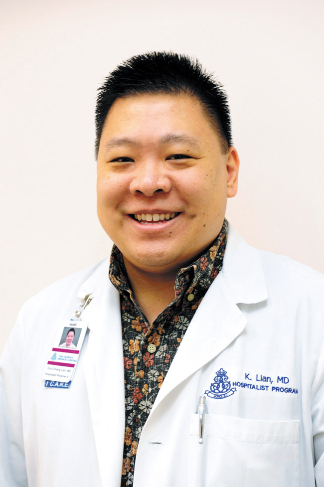Being There For The Patients
Dr. Kuo-Chiang Lian
Medical director of the hospitalist program at The Queen’s Medical Center
Where did you receive your schooling and training?
I received my undergraduate degree in chemistry at MIT and went to medical school at UCSF. I did my internship, residency and chief residency at UCLA. I was on faculty there for a few years and moved to Hawaii two-and-a-half years ago, when I joined the group at Queen’s. I also have a clinical appointment at the University of Hawaii John A. Burns School of Medicine.
How long have you been in practice?
Since 2009 as a full-time hospitalist. I have been fortunate to be the medical director for the hospitalist program at Queen’s since October. We have nearly 40 physicians in our group, with an incredible leadership team that supports me in caring for our patients.
What is a hospitalist and what is “hospital medicine”?
The field of hospital medicine focuses on comprehensive care of the patient in the hospital setting.
Most often, it involves caring for folks who are acutely ill and need urgent management of their medical or surgical problems to get them back to health and back in the care of their primary doctors. It is a recognized area of specialization and one of the fastest-growing fields of medicine today.
Hospitalist physicians have this particular acute-care focus and spend their time in the inpatient setting, coordinating the care of the patient with other team members. The vast majority of hospitalists specialize in internal medicine. In addition to providing quality, high-value care, hospitalists also participate in patient-safety initiatives, medical education of students and residents, and hospital administration.
A question I often get is, “Do you have a practice? Where’s your office?” I don’t have an outpatient office – I’m based at Queen’s and am dedicated to seeing patients in the hospital.
How did you choose the field of hospital medicine?
I like the idea of acute care and being there for the patients during their time of need. Some people are very sick and may be scared of receiving a serious diagnosis or of dying. I get to forge an intense, maybe brief, interaction with them, and take them through this journey. I’m also an instant-gratification kind of guy, so I enjoy figuring out the diagnosis, making an intervention and seeing the patient improve over hours or days.
The other aspect of hospital medicine I enjoy is working with hospital staff and colleagues. We take a team-care approach and involve the primary care doctor, the nurse, specialists, pharmacists, case managers, social workers and rehab therapists. We’re all working toward the same goal for the patient. The patient is an integral part of the care team, too. We love patients who are involved in their own care, who ask questions: “How can I be involved in my care right now?” “What can I do to maximize my health?” I enjoy being available all day in the hospital to focus on the patient’s needs. Oftentimes, we have family members come in, and we’re happy to meet with them as well.
What does a typical day look like in the hospital?
Usually, the day starts at 7 a.m., when we pick up any new patients admitted overnight from our night colleagues. Rounds in the hospital occur throughout the morning and include the team members mentioned above. Afternoons are usually reserved for follow-up tests, teaching, charting and revisiting the patient as necessary.
From the patient’s standpoint, if you are admitted to the hospital through the emergency room, a hospitalist will be in charge of your care from the point of admission until discharge, coordinating the management and maintaining a connection to the primary doctor.
What is a hospitalist’s work schedule like?
We work in blocks of seven days on with 12-hour days, followed by seven days off to rest. Effectively, we compress two 40-hour weeks into one week. Our Queen’s hospitalist group has doctors in house 24/7 to take care of our patients, with daytime doctors rounding on existing patients to move their care along. During the evening shift, we have doctors available to handle emergencies, evaluate inpatients as needed and admit patients from the emergency room.
Anything else you’d like to add?
We’re very excited that The Queen’s Medical Center-West Oahu is going to be opening May 20. We will have Queen’s hospitalists available there to take care of that patient population. We’re in a period of great growth, and it’s very exciting to be serving the West community. While it will be a community hospital setting and scope of services, we plan to offer the same level of high-quality inpatient care out at QMC-West as we do here downtown.






